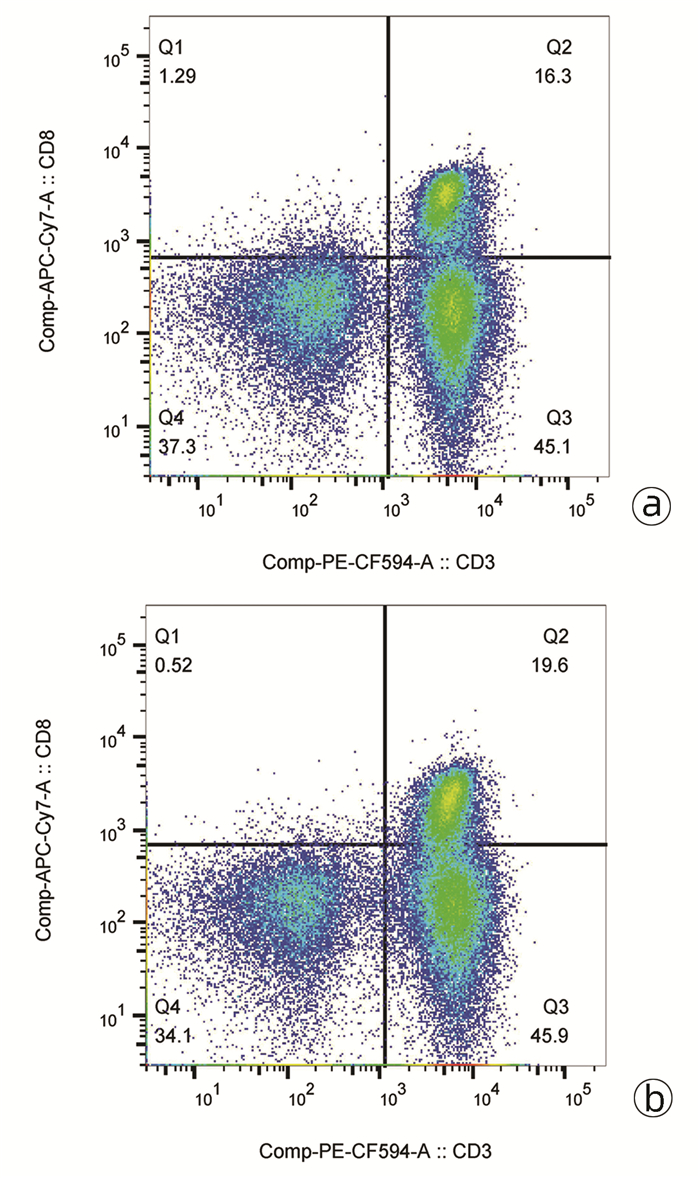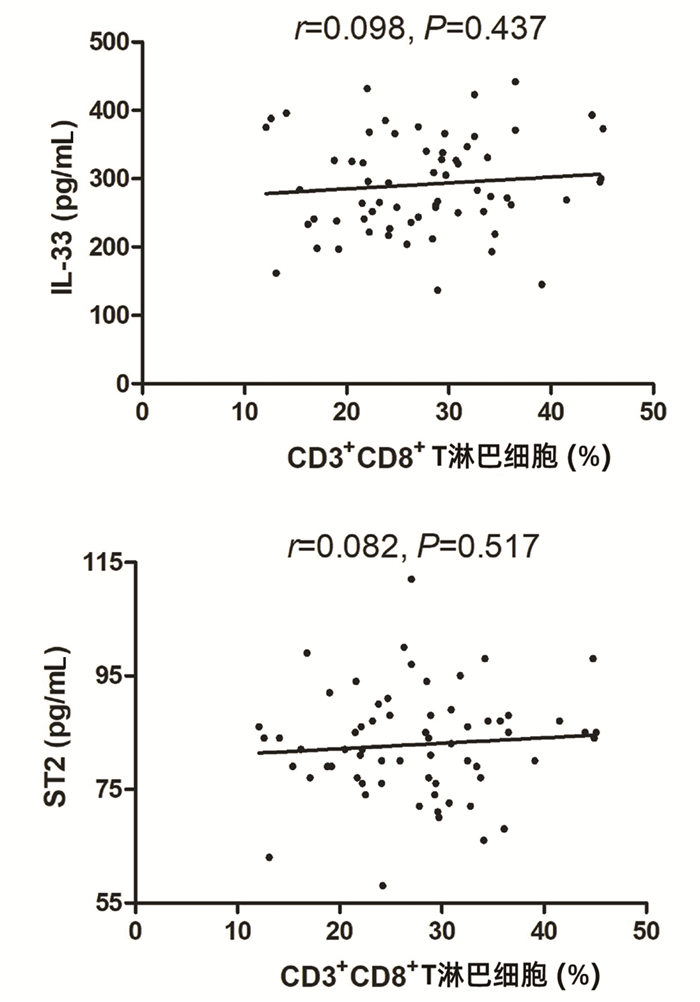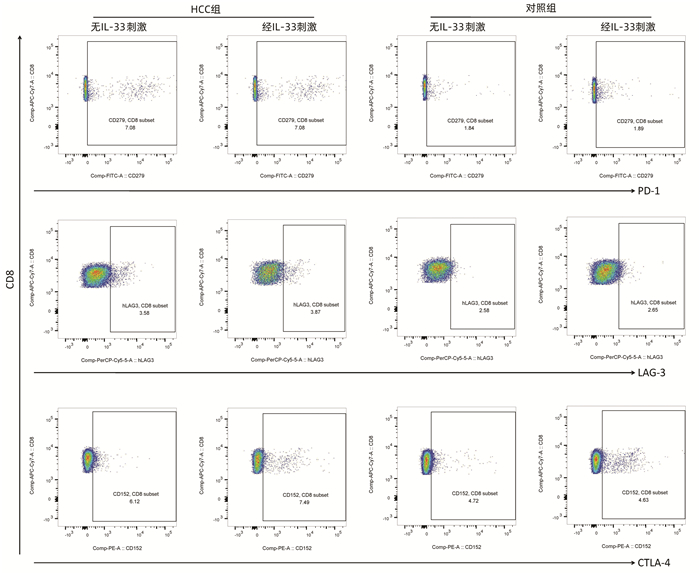| [1] |
CHEN Y, TIAN Z. HBV-induced immune imbalance in the development of HCC[J]. Front Immunol, 2019, 10: 2048. DOI: 10.3389/fimmu.2019.02048. |
| [2] |
HOFMANN M, TAUBER C, HENSEL N, et al. CD8 + T cell responses during HCV infection and HCC[J]. J Clin Med, 2021, 10(5): 991. DOI: 10.3390/jcm10050991. |
| [3] |
CAYROL C, GIRARD JP. Interleukin-33?(IL-33): A nuclear cytokine from the IL-1 family[J]. Immunol Rev, 2018, 281(1): 154-168. DOI: 10.1111/imr.12619. |
| [4] |
JIN Z, LEI L, LIN D, et al. IL-33 released in the liver inhibits tumor growth via promotion of CD4(+) and CD8(+) T cell responses in hepatocellular carcinoma[J]. J Immunol, 2018, 201(12): 3770-3779. DOI: 10.4049/jimmunol.1800627. |
| [5] |
LI A, HERBST RH, CANNER D, et al. IL-33 signaling alters regulatory T cell diversity in support of tumor development[J]. Cell Rep, 2019, 29(10): 2998-3008. e8. DOI: 10.1016/j.celrep.2019.10.120. |
| [6] |
Bureau of Medical Administrationnational Health Commission of The People's Republic of China. Guidelines for diagnosis and treatment of primary liver cancer in China (2019 edition)[J]. J Clin Hepatol, 2020, 36(2): 277-292. DOI: 10.3969/j.issn.1001-5256.2020.02.007. |
| [7] |
BOEGEL S, LÖWER M, BUKUR T, et al. A catalog of HLA type, HLA expression, and neo-epitope candidates in human cancer cell lines[J]. Oncoimmunology, 2014, 3(8): e954893. DOI: 10.4161/21624011.2014.954893. |
| [8] |
LI PP, ZHANG XM, YUAN D, et al. Decreased expression of IL-33 in immune thrombocytopenia[J]. Int Immunopharmacol, 2015, 28(1): 420-424. DOI: 10.1016/j.intimp.2015.06.035. |
| [9] |
XU H, TURNQUIST HR, HOFFMAN R, et al. Role of the IL-33-ST2 axis in sepsis[J]. Mil Med Res, 2017, 4: 3. DOI: 10.1186/s40779-017-0115-8. |
| [10] |
LU Y. Correlation of serum interleukin-33 with HBV DNA load and ALT level in patients with chronic hepatitis B[J]. J Clin Hepatol, 2015, 31(11): 1853-1856. DOI: 10.3969/j.issn.1001-5256.2015.11.020. |
| [11] |
ANTUNES MM, ARAÚJO AM, DINIZ AB, et al. IL-33 signalling in liver immune cells enhances drug-induced liver injury and inflammation[J]. Inflamm Res, 2018, 67(1): 77-88. DOI: 10.1007/s00011-017-1098-3. |
| [12] |
|
| [13] |
DU XX, SHI Y, YANG Y, et al. DAMP molecular IL-33 augments monocytic inflammatory storm in hepatitis B-precipitated acute-on-chronic liver failure[J]. Liver Int, 2018, 38(2): 229-238. DOI: 10.1111/liv.13503. |
| [14] |
KHAN HA, MUNIR T, KHAN JA, et al. IL-33 ameliorates liver injury and inflammation in Poly Ⅰ∶ C and Concanavalin-A induced acute hepatitis[J]. Microb Pathog, 2021, 150: 104716. DOI: 10.1016/j.micpath.2020.104716. |
| [15] |
YANG Y, WANG JB, LI YM, et al. Role of IL-33 expression in oncogenesis and development of human hepatocellular carcinoma[J]. Oncol Lett, 2016, 12(1): 429-436. DOI: 10.3892/ol.2016.4622. |
| [16] |
PENG C, HAN J, YE X, et al. IL-33 Treatment attenuates the systemic inflammation reaction in acinetobacter baumannii pneumonia by suppressing TLR4/NF-κB signaling[J]. Inflammation, 2018, 41(3): 870-877. DOI: 10.1007/s10753-018-0741-7. |
| [17] |
LV R, ZHAO J, LEI M, et al. IL-33 Attenuates sepsis by inhibiting IL-17 receptor signaling through upregulation of SOCS3[J]. Cell Physiol Biochem, 2017, 42(5): 1961-1972. DOI: 10.1159/000479836. |
| [18] |
BAO Q, LV R, LEI M. IL-33 attenuates mortality by promoting IFN-γ production in sepsis[J]. Inflamm Res, 2018, 67(6): 531-538. DOI: 10.1007/s00011-018-1144-9. |
| [19] |
ALVES-FILHO JC, SȎNEGO F, SOUTO FO, et al. Interleukin-33 attenuates sepsis by enhancing neutrophil influx to the site of infection[J]. Nat Med, 2010, 16(6): 708-712. DOI: 10.1038/nm.2156. |
| [20] |
NASCIMENTO DC, MELO PH, PIÑEROS AR, et al. IL-33 contributes to sepsis-induced long-term immunosuppression by expanding the regulatory T cell population[J]. Nat Commun, 2017, 8: 14919. DOI: 10.1038/ncomms14919. |
| [21] |
XIA Y, OHNO T, NISHⅡ N, et al. Endogenous IL-33 exerts CD8(+) T cell antitumor responses overcoming pro-tumor effects by regulatory T cells in a colon carcinoma model[J]. Biochem Biophys Res Commun, 2019, 518(2): 331-336. DOI: 10.1016/j.bbrc.2019.08.058. |
| [22] |
DREIS C, OTTENLINGER FM, PUTYRSKI M, et al. Tissue cytokine IL-33 modulates the cytotoxi CD8 T lymphocyte activity during nutrient deprivation by regulation of lineage-specific differentiation programs[J]. Front Immunol, 2019, 10: 1698. DOI: 10.3389/fimmu.2019.01698. |
| [23] |
ROOD JE, BURN TN, NEAL V, et al. Disruption of IL-33 signaling limits early CD8 + T cell effector function leading to exhaustion in murine hemophagocytic lymphohistiocytosis[J]. Front Immunol, 2018, 9: 2642. DOI: 10.3389/fimmu.2018.02642. |
| [24] |
WANG W, WU J, JI M, et al. Exogenous interleukin-33 promotes hepatocellular carcinoma growth by remodelling the tumour microenvironment[J]. J Transl Med, 2020, 18(1): 477. DOI: 10.1186/s12967-020-02661-w. |
| [25] |
ZHAO R, YU Z, LI M, et al. Interleukin-33/ST2 signaling promotes hepatocellular carcinoma cell stemness expansion through activating c-Jun N-terminal kinase pathway[J]. Am J Med Sci, 2019, 358(4): 279-288. DOI: 10.1016/j.amjms.2019.07.008. |








 DownLoad:
DownLoad:

